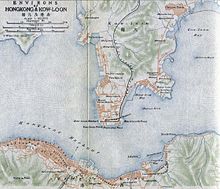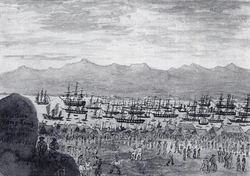- Victoria, Hong Kong
-
Victoria, Hong Kong 
A 1915 map showing Victoria City at the bottom Traditional Chinese 維多利亞城 Simplified Chinese 维多利亚城 Transcriptions Mandarin - Hanyu Pinyin Wéiduōlìyà Chéng - Wade–Giles Weitoliya Ch'eng - IPA [wěɪtwɔ́lɨ̂yɑ̂ tʂʰɤ̌ŋ] Cantonese (Yue) - Jyutping wai4 do1 lei6 aa3 sing4 - IPA [wɐi̭.dɔ́ː.lèi.ā.sɪ̭ŋ] - Yale Romanization wàih dō leih a sìhng Victoria, Victoria City, or statutorily, the City of Victoria,[1] was one of the first urban settlements in Hong Kong after it became a British colony in 1842. It was initially named Queenstown but was soon known as Victoria. It is often said to be the capital of Hong Kong,[2] and almost all government departments still have their head offices located within its limit.
Victoria City expanded over much of what is now Central, Sheung Wan, and Wan Chai.[3] However, the city name Victoria has been eclipsed by Central in popular usage.[4] It is nevertheless retained in the names of various organisations in reference to the Victoria City, such as the Victoria City District of the Hong Kong Scout,[5] and the Victoria Junior Chamber.[6] The name Victoria District Court had been in used at least way into the 1980s,[7][8][9][10] when it was moved to the Wanchai Tower and combined with other district courts in the territory.
Contents
Location
The city is centred in present-day Central, and named after Queen Victoria in 1843. It occupies the areas that are known in modern times as Central, Admiralty, Sheung Wan, Wan Chai, East Point, Shek Tong Tsui, the Mid-levels, the Peak, Happy Valley and Kennedy Town, on Hong Kong Island. In 1903, the Hong Kong Government erected seven boundary stones for the city, inscribed "City Boundary 1903" at Hatton Road (克頓道), Pok Fu Lam Road, Bowen Road, Old Peak Road (舊山頂道), Wong Nai Chung Road, Victoria Road/Sai Ning Street (西寧街) and Magazine Gap Road. All remain, except for the one in Magazine Gap Road, which disappeared around mid-June, 2007.[11][12][13]
History
In 1857, the British government expanded the scope of Victoria City and divided it into four "wans" (環, jyutping: waan4, pinyin: huàn, literally rings). The four wans are Sai Wan ("West Ring" in Chinese, present-day Sai Wan, including Kennedy Town, Shek Tong Tsui, and Sai Ying Pun), Sheung Wan ("Upper Ring" in Chinese, present-day Sheung Wan), Choong Wan or Chung Wan ("Central Ring" in Chinese, present-day Central) and Ha Wan ("Lower Ring" in Chinese, present-day Wan Chai). Except "Ha Wan"; "Sai Wan", "Sheung Wan" and "Choong Wan" retain the same name in Chinese today.
The four wans are further divided into nine "yeuks" (約, jyutping: joek3, pinyin: yuē, similar to "district" or "neighbourhood"). The coverage also included parts of East Point and Happy Valley (West of Wong Nai Chung Road on the east side of the Racecourse). In 1903, boundary stones were established to mark the City's boundary and six of them are still preserved today. The stones spread from Causeway Bay to Kennedy Town.[14]
In the 1890s the capital city extended four miles west to east along the coastal strip. Buildings were made of granite and brick. Buses and the new tramway would become the main form of transportation in the area.[15]
Districts
Also called yeuks.
- Shektongtsui
- Sai Ying Poon
- Taipingshan - Victoria Peak or The Peak or Mount Austin
- Sheung Wan
- Choong Wan (known in modern times as Central in English)
- Ha Wan (today's Admiralty)
- Wan Chai
- Bowrington (between today's Wan Chai and Causeway Bay)
- Soo Kun Po
See also
- Praya
- History of Hong Kong
- List of buildings, sites and areas in Hong Kong
- List of places named for Queen Victoria#Hong Kong, for a list of places named after Queen Victoria
References
- ^ Cap 1 Sched 1
- ^ The Hong Kong Institute of Architects Architecture Walk Central (2006), p.17
- ^ Wordie, Jason (2002). Streets: Exploring Hong Kong Island. Hong Kong University Press. p. 12. ISBN 9622095631.
- ^ Tsang, Steve (2004). A Modern History of Hong Kong. I.B. Tauris. p. 17. ISBN 1845114191.
- ^ Victoria City District
- ^ Victoria Junior Chamber
- ^ Volume 22 Inland Revenue Board of Review decisions
- ^ CACC497/1986 The Queen v. Chan Ngai Hung
- ^ CACC186A/1987 The Queen v Currency Brokers (H.K.) Ltd and Robert Lee Flickinger
- ^ CACC133A/1986 The Queen v. Wai Hin Keung
- ^ Antiquities and Monuments Office website: "Boundary Stone, City of Victoria"
- ^ List of boundary stones, with pictures (Chinese)
- ^ Apple Daily article about the boundary stones, 2007-08-19 (Chinese)
- ^ Wordie, Jason. [2002] (2002) Streets: Exploring Hong Kong Island. Hong Kong: Hong Kong University Press. ISBN 962-2095631
- ^ Sanderson, Edgar. [1897] (1897) The British Empire in the Nineteenth Century: Its Progress and Expansion at Home and Abroad. Blackie publishing. No ISBN digitalized doc from Stanford University.
External links
- Boundary of the City of Victoria as defined in Hong Kong Laws, Cap 1 SCHED 1 of Hong Kong Law
- Article on history of Hong Kong (Chinese)
- Photos of the 1903 boundary stones
- A article on the "four wans and nine yeuks" in Chinese (Adobe PDF format)
- Another article on "four wans and nine yeuks" (Chinese (PRC))
- Victoria City - Provisional Urban Council
- Victoria City - Provisional Urban Council
Coordinates: 22°16′42″N 114°10′28″E / 22.27833°N 114.17444°E
Categories:- Hong Kong Island
- Populated coastal places in Hong Kong
- Populated places in Hong Kong
Wikimedia Foundation. 2010.





